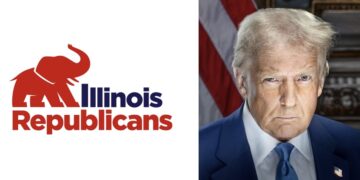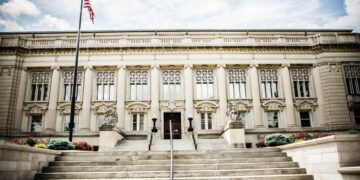By John F. Di Leo -
What is it that ends a recession, and finally brings about an economic boom?
After a long and painful “non-recovery recovery” – a decade-long stretch in which job growth and the labor force non-participation rate remained flat – the federal government has finally accomplished, in 2017, the primary contributions that it can make to bring about a real recovery:
By year-end, Congress had passed, and the president had signed, a long-overdue tax cut, reducing the tax rate that employers pay by nearly a half. It wasn’t enough, and we will need to add additional cuts in a phase two and phase three that are yet to come… but it was a critical first step.
Also in 2017, the Trump administration carried on an ongoing process of identifying and terminating illegal, unconstitutional, and otherwise destructive federal regulations. This process is both harder and easier than the tax cut process. It’s harder, in that every single rule has to be studied on its own, to determine whether it’s legal or not, and whether it’s helpful or not, before cancelling it… and it’s easier, in that this process requires no time-consuming Congressional involvement, since the goal here is to bring these agencies back into the boundaries that Congress set when they were first established – boundaries which have long since been disregarded under both Republican and Democrat administrations alike.
These tax rates and federal red tape were long among the primary federal roadblocks preventing economic growth. At long last, the federal government has finally done its job in largely lifting these burdens from the shoulders of the business sector.
Now, while there are still many things the federal government can do to help, the lion’s share of the work that remains is on the private sector, and the states.
America’s economic problems, primarily, are from American businesses moving production abroad, and American businesses struggling at home, and from would-be entrepreneurs simply not getting started at all, all due to the fact that our national tax system and our federal agency regulations have been too crippling. Now that these two major national burdens have been lessened – not removed, by any means, but yes, lessened – the United States will again see greater activity at home.
Many of our own conglomerates will start bringing more production back to their US factories from their overseas plants… more foreign companies will increase manufacturing at their US sites… and more American entrepreneurs will put their ideas into action with new start-ups.
But where, exactly, will all this happen? Well, that is largely up to the states themselves.
What A Difference A Border Makes.
When a company – especially a multinational conglomerate, with lots of sites all over the country – considers expanding a site, a great deal goes into that decision:
- Location – How convenient is this site to transportation, to the business’ vendors, workers, and customer base?
- Equipment – How easy will it be to expand this plant; will we need to buy new machinery or will the existing manufacturing cells, already in place, accommodate more volume?
- Personnel – Does this plant have access to experts in the specific skills we need, such as steel welders or tool-and-die makers or lathe operators, or will we have to recruit from far away?
But those are just the obvious ones. More and more nowadays, the key issues include these:
- Tax rates – Some states have no income tax at all, others have a high one; some have crippling workmen’s comp costs, some have outrageous property taxes, all of which play a role in what we have to pay our employees.
- Crime – Is our existing plant in a safe neighborhood? Will we need to hire special security for the parking lot? Will we lose desirable employees because they will fear going to and from work at this site?
- State Government Trajectory – Does the state have known problems that are sure to cause tax increases in the future? Is the state on track to solve its pension challenges and reduce its bureaucrat base through attrition, or are pensions and public school teacher tenure twin time bombs for them, sure to explode in the near future?
As just one example, consider one of the biggest business announcements of 2017: Foxconn’s decision to build a ten billion dollar plant in southeast Wisconsin.
Why Wisconsin? Why not thirty or forty miles south in Illinois?
Because there are differences between the states. In fact, as the federal burden on the private sector has been reduced, the differences between the states grow even more glaring.
Wisconsin and Illinois had similar pension crises a decade ago, but Wisconsin tackled theirs in 2011, while Illinois has continued to kick the can down the road. This means that when Illinois finally does address the issue, it will be far worse, far more expensive, due to all these added years of accumulation.
All states have crime, but which states prosecute criminals for the crimes they commit, and which ones are more likely to let criminals go free, or to plea-bargain them down in the interest of easier convictions and shorter time behind bars?
And even more outrageously, which states introduce a formal policy of releasing convicts from prison due to lack of cell space, sending the clear message that even completely successful prosecutions won’t protect the neighborhood from known criminals?
All states have illegal aliens, but which ones are cooperating with the federal government in an effort to end the infestation, and which ones are inviting them in, with well-publicized “sanctuary cities” and generous welfare benefits? More shocking still, which states are offering voting rights to illegal aliens, blatantly flouting their violation of federal law, weakening the vote of their own legitimate residents in the process?
These differences between the states have risen to the top of the headlines in recent weeks, as the 2017 tax reform has focused attention on the so-called “blue state model” of high tax rates and huge government payrolls that are crippling Illinois, New York, New Jersey and California. But as we’ve seen, even without the 2017 tax reform’s removal of some of the federal tax breaks for state and local taxes, the many other weaknesses of the blue states were going to affect where the coming recovery took hold anyway.
The Blue States’ “Do Not Enter” Signs
Almost every day, there is a news report of some warning about the blue states:
- A Cook County Commissioner – Richard Boykin – makes national newss, begging the United Nations to send in their blue helmets to help control crime in Chicago, since the local government refuses to.
- A Somali “refugee” knifes a young woman – Morgan Evenson – fourteen times, on her way home from work in downtown Minneapolis, and the city’s biased press refuses to cover the story.
- A California jury acquits a killer who had been deported at least five times before murdering Kate Steinle in cold blood in 2015.
Such stories are filed away in the minds of businessmen and would-be entrepreneurs. They may not register fully at the time, not being relevant to the day’s business, but they are available when decisions come up, weeks or months later.
Given the choice between expanding the Texas plant or the Illinois plant, the businessman adds that news story to his data set. Given the choice between the California plant and the Oklahoma plant… or the choice between the New York plant and the Florida plant… these news stories will play a role, and the once-obvious desirable locales of New York City, San Francisco, and Chicago will lose out to safer, more sensible areas like Dallas, Tulsa, and Jacksonville.
Some states have come around, and made the right decisions – at the state level – in recent years. Some states have been making the right decisions for generations.
And some states still stubbornly refuse to make the right decisions, even today, when all the evidence is in, and there is no longer any excuse.
In a republic – and thank Heaven, this is a republic, if we can keep it – “elections have consequences.”
copyright 2017 John F. Di Leo
John F. Di Leo is a Chicagoland-based international trade compliance manager, writer and actor. His columns appear regularly in Illinois Review. Permission is hereby granted to forward freely, provided it is uncut and the byline and IR URL are included.







